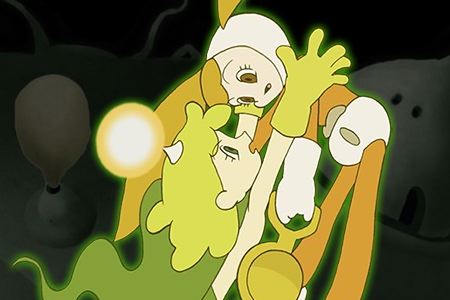Ask John: Why is Kaiba Being Overlooked?

Question:
I don’t see any groups fansubbing Kaiba. Why not?
Answer:
Rather than argue the morality of fan distribution of new anime and the ethics of fansubbing, I’m simply going to address the program at the heart of this question.
At the time I compose this response, only one episode of Madhouse and director Maasaki Yuasa’s new anime television series Kaiba has aired on Japanese television. Kaiba is one of nearly fifty new anime television series to have premiered during the spring 2008 season. Having watched more than 30 of the current season’s premiers so far, I can confidently say that Kaiba is one of, if not the very best new anime of the season. In fact, the first episode of Kaiba is so distinct and so unconventional that even if no additional episodes ever come to light, the first episode alone is amazing enough to have secured a permanent noteworthy place in the history of anime.
As revealed by its first episode, Kaiba appears to be a modern fairy tale about a boy that wakes in a strange and dangerous world, with no memories of who he is and a hole through his body where his heart should be. Coming as little surprise from a director well known for producing eclectic, highly artistic animation, Kaiba is a collection of a tremendous variety of influences and homages.
The show’s visual design recalls French new wave comics from artists such as Philippe Caza and Jean “Moebius” Giraud while its character design resembles the work of veteran manga artist Fujio Akatsuka’s Tensai Bakabon and Moretsu Ataro. The episode’s atmosphere and direction feel reminiscent of Osamu Tezuka’s experimental animation; the kinetic action of Koji Morimoto; the slapstick physical comedy of vintage American children’s cartoons; and the moody, abstract tone of Mamoru Oshii’s oeuvre. The first episode of Kaiba deftly transitions through different tones, influences, and feelings while creating a seamless and fascinating singular narrative that feels as much like a personal “art film” as mainstream entertainment.
However, the drastic difference between the look and feel of Kaiba and every other contemporary anime may be largely responsible for why the program has generated so little interest among American anime fans. Typical observers probably wouldn’t recognize Kaiba as anime at all because it superficially bears so little resemblance to the typical characteristics of anime that many Americans use to define anime. Furthermore, the visual design and advertising of Kaiba all create an impression that the series is an anime for children. children’s anime are consistently dismissed and ignored by the majority of America’s anime fan community. Based on its first episode, it’s seemingly not unfair to call Kaiba a children’s anime, but that classification feels inadequate to reasonably describe how breathtaking and fascinating the show can be for any viewer that appreciates exceptional animation and film.
Despite the series presently having just one episode, Kaiba already seems destined to be a memorable and exceptional anime masterpiece. Hopefully, as the series continues, more international fans will set aside their presumptions about the show and actually watch some of it to see, first hand, what the program is really like.
Add a Comment
You must be logged in to post a comment.


Actually one fansub group has announced that they will be translating Kaiba and I wouldn’t be all that surprised if one or both of the groups that translated Kemonozume would pick this one up as well.
Wait a month or two before complaining about fan-translations, particularly when it comes to offbeat stuff like Kaiba. I agree that Kaiba itself had a pretty impressive series premiere. It looks to be as wildly imaginative as last year’s Dennou Coil.
I agree that expecting a fan translation of a show only a few days after it airs may be premature – even though it happens often these days. Honestly, this article was just an excuse for me to direct some attention to this great new show.